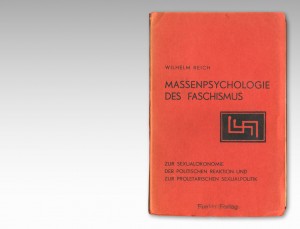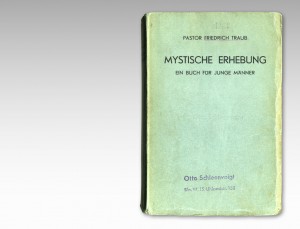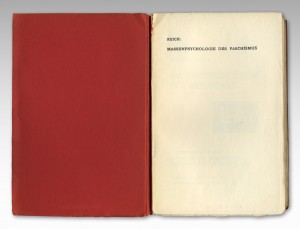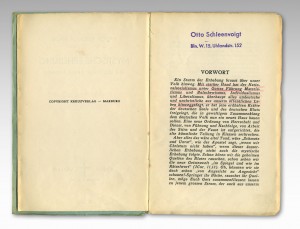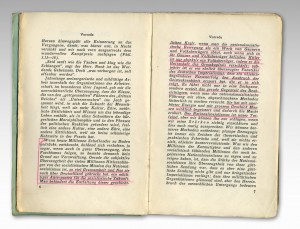by Andreas Peglau
*
Germans who read in late 1933 or later Mystische Erhebung. Ein Buch für junge Männer by Pastor Friedrich Traub, had no reason to be surprised at first: one more church representative who paid homage to the Nazi regime. Right at the beginning it said:
„With a strong hand, National Socialism, under God’s guidance, has swept away materialism and Bolshevism, individualism and liberalism, and in general everything un-German and un-Christian from our public life.“
If they stopped reading at this point and refrained from further investigation, they might have seen no reason why the possession of this writing could endanger them. On closer examination, however, they would have come to a very different conclusion.
First of all: The „Kreuz“ publishing house Marburg, in which Mystische Erhebung had allegedly appeared, did not exist. The author of the book was also shrouded in mystery. In the files of the Protestant church a man with the same name could have been found: the Protestant missionary Friedrich Traub. However, he had already died of typhoid fever in Jiujiang, China, on February 8, 1906, at the age of 33. Before that, the native Swabian had written several church songs, the most famous of which was called „Jesus lebet, Jesus sieget!“ (Hägele p. 10ff.). But he had never written books.
Already on page two of the preface to Mystische Erhebung the conclusion suggests itself that Traub must have had not only an amazing afterlife, but also schizophrenic features. The fervent „right-wing“ confession was followed by a radical change of heart. Introduced by the already slightly irritating information that the author had worked within workers‘ organizations, the „godliness“ of the Nazi leaders is questioned by quotation marks, then those who were labeled „subhumans“ by them are appreciated as bearers of the „future of mankind“. Afterwards it is said: „If today millions of creative people follow fascism, […] there is nevertheless no reason for despair“. But that’s not all: „Hitler is […] objectively a people’s deceiver“, whom his
„huge success […] has spared the outbreak of a mental illness, which he carries within himself […]. National Socialism is our mortal enemy, but we can only beat it if we correctly assess its strengths and courageously say so.“
In this style and with this content it now continued, on a total of 283 pages. What had happened? The readers had in fact come across the text of Massenpsychologie des Faschismus, written by the well-known psychoanalyst, sexual reformer and communist Wilhelm Reich!
Reich had published the original edition of this writing in August or September 1933 in his Danish exile at his own Sexpol-Verlag. But he printed his book again: with an innocuous cover and a „right-wing“-heavy introduction, which he allowed to merge into the original text on page two.
As other emigrated authors did, he made sure that this camouflage edition reached the Hitler state. Reich mentioned this in the preface of The Mass Psychology of Fascism (p. 14f.), the 1946 English-language new edition:
„The book was smuggled across the German border in great numbers, often under disguise, and was enthusiastically received by the illegal revolutionary movement in Germany.“[1]
It has not yet been possible to prove this, since apparently virtually no camouflaged copies have survived. Even in the Bundesarchiv (Federal Archives) in Berlin, which have an impressive collection of camouflage editions, there is not even a reference to it (as of 2013).
In this respect, it was a minor sensation when, in the course of my research on psychoanalysis under National Socialism, I was presented with precisely that book. Heinz Peter, the now unfortunately deceased librarian and co-founder of the Peter Weiss Library in Berlin, had discovered it in the estate of a former member of the KPD.
Another bogus argument that Reich’s autobiographical details were allegedly highly inaccurate and exaggerated burst.
Incidentally, the Berlin address books reveal: Otto Schleenvoigt, the man whose name is stamped on Reich’s camouflage edition (see illustrations), actually existed. In 1932 at the latest, he lived at Pfalzburger Strasse 80, Berlin W. 15. By profession, he was a nurse. From 1940 to 1942 he is not listed, perhaps because of war service. Then he shows up as a janitor at Uhlandstr. 152 – exactly as stamped on the envelope. So it looks as if he got hold of the book quite late. If it was still before 1945, he would have taken a considerable risk with it.
The images below show the front cover and the first pages of the original and the camouflage edition in comparison.
For better readability please click into the pictures.
[1] This is presumably what Eric Bentley is referring to when he reports in his preface to the English version of Bertolt Brecht’s Galileo Galilei that Reich had books made that „looked like prayer books“ and sent them to Germany (Bentley 1966, p. 15). Bentley’s book was brought to my attention by Philip Bennett.
Sources:
Hägele, Friedemann (Hg.) (1995): Friedrich Traub – ein Pionier der Chinamission. Aus Liebe zu Christus, Holzgerlingen.
Peglau, Andreas (2017): Unpolitische Wissenschaft? Wilhelm Reich und die Psychoanalyse im Nationalsozialismus.3rd, corrected and expanded edition 2017, Gießen.
Reich, Wilhelm (1946): The Mass Psychology of Fascism, New York.
Reich, Wilhelm (1995): Menschen im Staat, Frankfurt a. M.
Reich, Wilhelm (2020): Massenpsychologie des Faschismus. Der Originaltext, Gießen.
Berliner Adressbücher: http://www.zlb.de/besondere-angebote/berliner-adressbuecher.html
The first part of this article was taken from A. Peglau, „Mystische Erhebung. Pastor Traub and Wilhelm Reich“ (Werkblatt. Zeitschrift für Psychoanalyse und Gesellschaftskritik. Nr. 70 (2013), S. 118-127).

